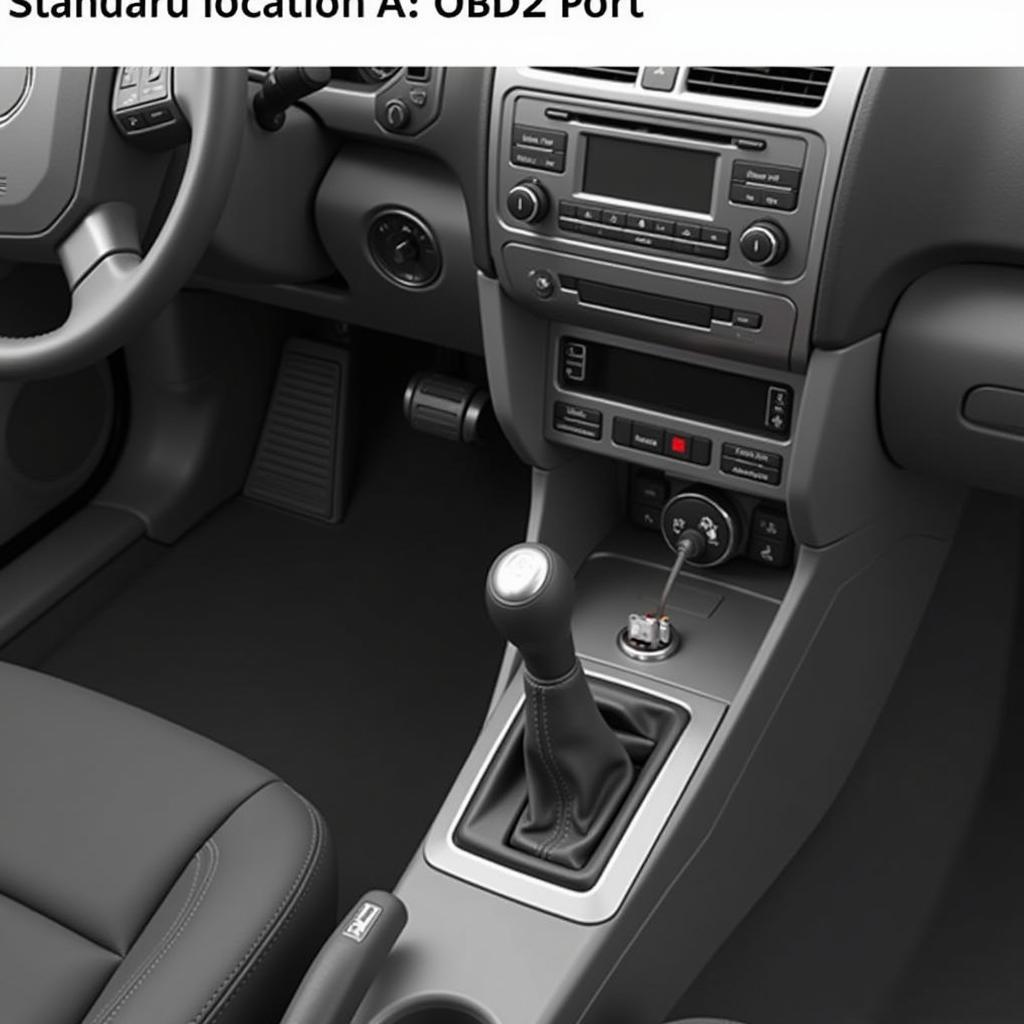Modern vehicles are equipped with sophisticated onboard computer systems that monitor and control various aspects of engine performance, emissions, and overall functionality. This system, known as On-Board Diagnostics II (OBD2), plays a crucial role in car diagnostics. By understanding how to utilize the power of OB2 auto diagnostics, car owners can gain valuable insights into their vehicle’s health, identify potential issues early on, and even save money on costly repairs.
Decoding the Language of Your Car: What is OBD2 Auto Diagnostics?
Introduced in the mid-1990s, OBD2 is a standardized system that allows external devices to communicate with a vehicle’s computer system. At its core, OBD2 auto diagnostics involve retrieving and interpreting diagnostic trouble codes (DTCs), which are stored in the vehicle’s computer memory. These codes act as indicators, signaling potential malfunctions within various systems.
 OBD2 Port Location in a Car
OBD2 Port Location in a Car
Think of it as your car’s way of “talking” to you, using these codes to communicate what might be going wrong.
The Power of OBD2 Auto: Benefits for Car Owners
Gone are the days when diagnosing car problems was a guessing game reserved for experienced mechanics. OBD2 auto diagnostics empower car owners with a range of benefits:
- Early Detection and Prevention: By regularly scanning for and interpreting DTCs, car owners can detect potential issues before they escalate into major problems. This proactive approach allows for timely maintenance and can save significant costs in the long run.
- Accurate Diagnosis: OBD2 scanners provide precise information about the nature of the problem, eliminating guesswork and unnecessary repairs.
- Enhanced Understanding: Car owners can gain a deeper understanding of their vehicle’s overall health and performance by monitoring various parameters such as engine temperature, fuel efficiency, and emissions.
- Cost Savings: By identifying issues early on, car owners can address them before they require expensive repairs. Additionally, the ability to perform basic diagnostics at home can reduce reliance on expensive mechanic visits.
 Mechanic Using an OBD2 Scanner
Mechanic Using an OBD2 Scanner
Choosing the Right Tool: OBD2 Scanners Explained
The gateway to unlocking the power of OBD2 auto diagnostics lies in using an OBD2 scanner. These handheld devices vary in features and complexity, catering to different needs and budgets:
- Basic Code Readers: These entry-level scanners provide a simple readout of DTCs, allowing you to identify the general area of concern.
- Advanced Scan Tools: Offering a wider range of features, advanced scanners can provide live data streams, graph sensor readings, and even perform specific functions such as resetting the check engine light.
- Smartphone Apps: For DIY enthusiasts, numerous smartphone apps utilize Bluetooth-enabled OBD2 adapters to provide diagnostic information directly on your mobile device.
For a comprehensive guide to choosing the best OBD2 scanner for your needs, visit our article on the best car engine fault diagnostic scanner.
Beyond the Codes: Interpreting OBD2 Data
While retrieving DTCs is a crucial aspect of car diagnostics, interpreting the data accurately is equally important. Each DTC corresponds to a specific issue, and understanding its meaning allows you to pinpoint the root cause of the problem.
 Looking Up OBD2 Codes Online
Looking Up OBD2 Codes Online
For instance, a code related to the oxygen sensor might indicate a problem with the sensor itself or a leak in the exhaust system. Further investigation and potentially additional diagnostic steps might be required to determine the exact cause.
Case Study: Car Diagnostics OB2 Auto Lexus GS300 ELM327
Let’s look at a real-world example. A Lexus GS300 owner notices the check engine light illuminated on their dashboard. Using a simple OBD2 code reader, they retrieve the code P0171, indicating a “System Too Lean (Bank 1).” This code suggests that the engine is receiving too much air compared to fuel.
Further investigation using an advanced scan tool allows the owner to monitor the oxygen sensor readings and fuel trim values, confirming the lean condition. Based on this information, the owner can narrow down the potential causes to a vacuum leak, a faulty mass airflow sensor (MAF), or a problem with the fuel injectors.
This example highlights the power of OBD2 auto diagnostics in providing valuable information to guide the troubleshooting process and enable informed repair decisions.
“In my experience, understanding how to use OBD2 diagnostics is like having a secret weapon in your car maintenance arsenal. It empowers car owners to take control of their vehicle’s health and make informed decisions,” says automotive expert, John Smith, ASE Certified Master Technician.
Conclusion: Empowering Car Owners through Technology
Car diagnostics have come a long way from the days of trial and error. OBD2 auto diagnostics, with its ability to provide real-time insights into a vehicle’s health, has revolutionized the way we maintain and repair our cars. By understanding the basics of OBD2 and utilizing the right tools, car owners can become more proactive in their vehicle maintenance, detect potential issues early on, and potentially save significant costs in the long run.
Remember, staying informed about your car’s health is crucial. Embrace the power of OBD2 auto diagnostics and take control of your vehicle’s well-being.

Leave a Reply